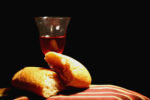 Sacrament: A physical symbol that acts as a means of God’s grace by which we participate in a spiritual reality.
Sacrament: A physical symbol that acts as a means of God’s grace by which we participate in a spiritual reality.
This Sunday at Central we’re beginning a 13-weeks Bible class series on the sacraments of baptism, communion, and the Christian assembly. Our intent is to move more toward viewing these special moments together as places and times when our God is redemptively present and seriously at work. We want to learn how to focus more on what God is doing and less on what we are doing in these practices. And the word “sacrament” is significant for our understanding and growth.
The definition above is my own version of how the Church has understood the term for centuries. Let’s explain it using each of the divine ordinances.
 Baptism – The physical symbol is the water. The water is real, it’s tangible. You can see it, you can feel it, you can experience it. It’ll ruin your phone, it’ll go up your nose — it’s real. But the water also represents a reality beyond itself. It points to something bigger. The water symbolizes the death, burial, and resurrection of Jesus. What makes baptism a sacrament is that, by God’s Spirit, we actually participate in the reality it symbolizes. In baptism, we are buried and raised with Christ Jesus. Baptism connects us to Christ’s death and resurrection.
Baptism – The physical symbol is the water. The water is real, it’s tangible. You can see it, you can feel it, you can experience it. It’ll ruin your phone, it’ll go up your nose — it’s real. But the water also represents a reality beyond itself. It points to something bigger. The water symbolizes the death, burial, and resurrection of Jesus. What makes baptism a sacrament is that, by God’s Spirit, we actually participate in the reality it symbolizes. In baptism, we are buried and raised with Christ Jesus. Baptism connects us to Christ’s death and resurrection.
“Don’t you know that all of us who were baptized into Christ Jesus were baptized into his death? We were therefore buried with him through baptism into death in order that, just as Christ was raised from the dead through the glory of the Father, we too may live a new life. If we have been united with him like this in his death, we will certainly also be united with him in his resurrection.” ~Romans 6:3-5
 Lord’s Supper – The physical symbol is the bread and the cup, the cracker and the juice. Those are concrete, real things, physical things. You can smell the juice, you can crunch the cracker; it gets stuck in your teeth, it can stain your slacks — it’s real. But the meal represents Jesus eating and drinking with his disciples. What makes the communion meal a sacrament is that, by God’s Holy Spirit, we actually are participating in the thing it represents. We are literally eating with the Lord. Somehow, mysteriously, yes, he meets us at the table and eats with us.
Lord’s Supper – The physical symbol is the bread and the cup, the cracker and the juice. Those are concrete, real things, physical things. You can smell the juice, you can crunch the cracker; it gets stuck in your teeth, it can stain your slacks — it’s real. But the meal represents Jesus eating and drinking with his disciples. What makes the communion meal a sacrament is that, by God’s Holy Spirit, we actually are participating in the thing it represents. We are literally eating with the Lord. Somehow, mysteriously, yes, he meets us at the table and eats with us.
“Is not the cup of thanksgiving for which we give thanks a participation in the blood of Christ? And is not the bread that we break a participation in the body of Christ?” ~1 Corinthians 10:16
 Christian Assembly – The physical symbol is the people in the room. It’s us. Real men, women, and children, wearing clothes, laughing, singing, whispering, chewing gum, praying; babies crying and people sneezing — it’s real. And it symbolizes something bigger. It represents the heavenly assembly around the throne of God. By God’s Spirit, we join that heavenly chorus — we are actually participating in what we can’t see yet. We are singing and praying with all the saints of all time in heaven, in the eternal presence of God. That’s what makes the Sunday morning worship gathering a sacrament.
Christian Assembly – The physical symbol is the people in the room. It’s us. Real men, women, and children, wearing clothes, laughing, singing, whispering, chewing gum, praying; babies crying and people sneezing — it’s real. And it symbolizes something bigger. It represents the heavenly assembly around the throne of God. By God’s Spirit, we join that heavenly chorus — we are actually participating in what we can’t see yet. We are singing and praying with all the saints of all time in heaven, in the eternal presence of God. That’s what makes the Sunday morning worship gathering a sacrament.
“You have come to Mount Zion, to the heavenly Jerusalem, the city of the living God. You have come to thousands upon thousands of angels in joyful assembly, to the Church of the firstborn, whose names are written in heaven. You have come to God, the judge of all people, to the spirits of righteous men and women made perfect, to Jesus, the mediator of a new covenant…” ~Hebrews 12:22-24
God is present with us, saving us, nourishing us, changing us. When we view these three ordinances as merely commands to obey, we’ll focus on what we are doing. When we understand them as sacraments, we’re better able to focus on what God is doing.
Peace,
Allan
Leave a Reply